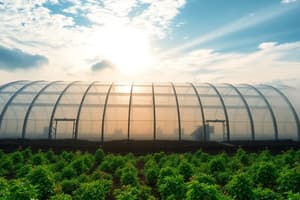Podcast
Questions and Answers
What is a common action that is taken with the content on https://www.studiestoday.com?
What is a common action that is taken with the content on https://www.studiestoday.com?
- Viewing it as a printed publication
- Embedding it in other websites
- Sharing it on social media
- Downloading it for offline access (correct)
Which of the following best describes the frequency of the action related to the content?
Which of the following best describes the frequency of the action related to the content?
- Occasional and rarely repeated
- Infrequent and limited to specific topics
- Consistent and recurring from diverse sources (correct)
- Completely randomized without pattern
Which option could represent a misconception about the content on this site?
Which option could represent a misconception about the content on this site?
- It provides only downloadable content
- It requires a subscription for access (correct)
- It is not accessible for everyone
- It can be used for educational purposes
Why might someone choose to download content from this site?
Why might someone choose to download content from this site?
What implication does the repetitive mention of downloads suggest about the site's usage?
What implication does the repetitive mention of downloads suggest about the site's usage?
What is likely a primary activity occurring at the mentioned URL?
What is likely a primary activity occurring at the mentioned URL?
How might the frequent references to downloads impact users?
How might the frequent references to downloads impact users?
What can be inferred about the types of resources available on the site?
What can be inferred about the types of resources available on the site?
Why might a user repeatedly mention downloading when discussing the site?
Why might a user repeatedly mention downloading when discussing the site?
What should users be cautious about when frequently downloading from a site?
What should users be cautious about when frequently downloading from a site?
What is a potential downside of a site that heavily emphasizes downloading?
What is a potential downside of a site that heavily emphasizes downloading?
What conclusion might be drawn about user behavior related to the site?
What conclusion might be drawn about user behavior related to the site?
Which of the following could NOT be a reason for users to frequently visit the site?
Which of the following could NOT be a reason for users to frequently visit the site?
Flashcards are hidden until you start studying
Study Notes
The Earth's Atmosphere
- The Earth's atmosphere is a layer of gases that surrounds the planet.
- It is essential for life on Earth, as it provides oxygen for breathing, protects us from harmful radiation, and regulates the Earth's temperature.
- The atmosphere is composed of 78% nitrogen, 21% oxygen, and 1% other gases.
- These gases are held to the Earth by gravity.
Structure of the Atmosphere
- The Earth's atmosphere is divided into several layers based on temperature.
- The layers include the troposphere, stratosphere, mesosphere, thermosphere, and exosphere.
Troposphere
- The troposphere is the lowest layer of the atmosphere.
- It is where most weather occurs.
- It extends up to about 10 kilometers above the Earth's surface.
- Temperature decreases with altitude in this layer.
Stratosphere
- The stratosphere is located above the troposphere and extends up to about 50 kilometers.
- It contains the ozone layer, which absorbs harmful ultraviolet radiation from the sun.
- Temperature increases with altitude in this layer.
Mesosphere
- The mesosphere is located above the stratosphere and extends up to about 80 kilometers.
- It is the coldest layer of the atmosphere.
- Meteors burn up in this layer, generating shooting star effects.
Thermosphere
- The thermosphere is located above the mesosphere and extends up to about 500 kilometers.
- It is the hottest layer of the atmosphere.
- This layer absorbs the most extreme ultraviolet and x-ray radiation from the sun.
The Ozone Layer
- The ozone layer is a region of the stratosphere that contains a high concentration of ozone gas.
- Ozone absorbs ultraviolet radiation from the sun, which is harmful to life on Earth.
- It is located in the lower stratosphere, extending about 15 to 35 kilometers above the surface of the Earth.
- The ozone layer has been depleted in recent decades due to the release of man-made chemicals called chlorofluorocarbons (CFCs).
- The depletion of the ozone layer is a major environmental concern, as it could lead to increased levels of skin cancer and other health problems.
Climate Change and the Atmosphere
- The Earth's climate is changing due to the increasing levels of greenhouse gases in the atmosphere.
- Greenhouse gases trap heat in the atmosphere, causing the Earth to warm.
- The primary greenhouse gases are carbon dioxide, methane, nitrous oxide, and fluorinated gases.
- Human activities, such as burning fossil fuels, deforestation, and agriculture, are the major contributors to the increase in greenhouse gas concentrations.
- Climate change is a serious threat to life on Earth, as it could lead to more extreme weather events, rising sea levels, and other devastating consequences.
The Indian National Congress
- Founded in 1885, the Indian National Congress (INC) emerged as a platform for educated Indians to voice their grievances against British rule.
- Early leaders were primarily moderate and sought reforms within the existing British framework, advocating for greater Indian representation and a gradual transition towards self-rule.
- The Congress's initial appeal was primarily to the English-educated elite of urban centers.
- Gradually, the Congress evolved into a platform for a wider range of political aspirations, attracting leaders with more radical perspectives.
- The Congress's early demands were centered around achieving a greater role for Indians in the British administrative system.
- The Congress's policies and strategies evolved over time, influenced by shifting political realities and the growing nationalist sentiment within India.
- The INC ultimately played a pivotal role in shaping India's independence movement, uniting diverse social groups and mobilizing public opinion against British rule.
Moderates & Extremists
- The early INC leaders, known as Moderates, believed in achieving self-rule through constitutional means and by appealing to British sense of justice and fair play.
- Moderates aimed to secure increased representation in legislative councils and work towards a gradual process of self-governance.
- Their approach emphasized reform, education, and the use of petitions and appeals to the British government.
- Extremists, emerging within the Congress later, were more radical and advocated for more assertive measures to attain independence.
- They saw the need to challenge British authority directly, emphasizing the potential for mass movements and the use of non-cooperation.
Formation of Muslim League
- The Muslim League, founded in 1906, emerged as a separate platform representing the interests of Muslims in India.
- Its initial aim was to safeguard the rights and interests of Muslims, who felt that their concerns were insufficiently addressed by the Congress.
- Over time, the League's agenda became more politically charged, leading to increased competition and tension with the Congress.
Home Rule League
- The Home Rule League, founded in 1916, emerged as a campaign demanding self-rule for India.
- The League's main objective was to promote and advocate for Swaraj, or self-rule, through a mixture of constitutional means and public pressure.
- The League's campaign contributed to the growing momentum for Indian independence, mobilizing public opinion and raising awareness of the need for a greater level of autonomy from British rule.
The Non-Cooperation Movement
- The Non-Cooperation Movement, launched in 1920, was a significant turning point in the Indian independence movement.
- This non-violent movement called for Indians to boycott British institutions and goods, including courts, legislative councils, and educational institutions.
- The movement was suspended in 1922 due to a violent incident in Chauri Chaura, where protestors clashed with police, leading to casualties.
- The non-cooperation movement, while short-lived, served as a powerful demonstration of Indian national unity and resistance against colonial rule.
Civil Disobedience Movement
- The Civil Disobedience Movement, launched by Mahatma Gandhi in 1930, aimed to challenge and undermine British rule.
- The movement involved various forms of non-violent resistance, including the Salt Satyagraha, where people defied the British salt tax.
- The movement aimed to pressure the British government into granting India greater autonomy and eventually independence.
Forward Bloc
- Founded in 1939, the Forward Bloc was formed by Subhas Chandra Bose.
- It aimed to push for immediate independence and even considered seeking support from the Axis powers during World War II.
- The Forward Bloc represented a more radical wing of the Indian nationalist movement, seeking complete freedom from British rule without compromise.
Quit India Movement
- The Quit India Movement, or the August Movement, was launched in 1942.
- It demanded immediate independence from British rule following the rejection of the Cripps Mission proposals, which aimed at post-war constitutional changes.
- The movement involved nationwide protests, strikes, and boycotts, leading to a significant crackdown by the British authorities.
Partition of India
- After World War II, the British government announced its intention to grant India independence.
- The decision to partition the country into India and Pakistan was prompted by communal tensions and the demand for a separate homeland for Muslims.
- The partition resulted in mass displacement, violence, and loss of life, marking a tragic chapter in Indian history.
Indian Independence Act 1947
- The Indian Independence Act 1947 marked the end of British rule and the beginning of independent India and Pakistan.
- The Act granted independence to India and Pakistan, while transferring power and responsibility to the newly formed governments.
Independence of India
- India achieved independence on August 15, 1947.
- The country faced significant challenges as it embarked on its journey as a newly independent nation.
Factors Leading to Independence
- The rise of Indian nationalism, fueled by growing awareness of colonial exploitation and a yearning for self-rule, played a pivotal role.
- The leadership of Mahatma Gandhi in promoting non-violent resistance inspired Indians to fight for freedom.
- The participation of Indians in World War II, which highlighted British reliance on Indian manpower, further strengthened the independence movement.
- International pressure on Britain to grant independence, combined with the weakening of the British Empire after the war, also contributed to India's eventual independence.
Studying That Suits You
Use AI to generate personalized quizzes and flashcards to suit your learning preferences.





